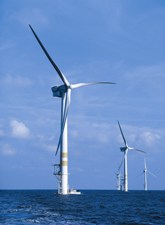Floating Wind Farms
Even some energy-conscious Massachusetts residents oppose a plan to put dozens of electricity-generating wind turbines on towers about eight kilometers off the southern coast of Cape Cod, saying they would be an eyesore. But huge turbines in development at General Electric could make battles with coastal residents a thing of the past. Researchers say the turbines could be placed on floating platforms, far at sea and invisible from the shore.

In March, GE announced a $27 million partnership with the U.S. Department of Energy to develop 5- to 7-megawatt turbines by 2009, supplanting the company’s current 3.6-megawatt turbines. Each of these giant energy factories, with rotors 140 meters in diameter, would produce enough electricity to power up to 1,750 homes – and at a more economical rate than smaller turbines, since the cost of building offshore wind farms depends more on the number of turbines than on their size.
Meanwhile, a group of MIT researchers led by Paul Sclavounos, a professor of mechanical engineering and naval architecture, have demonstrated the feasibility of placing such turbines atop large floating cylinders ballasted with concrete and anchored to the seafloor by cables. With this design, wind farms could be located in water ranging from 30 meters deep to 300 – far out on the continental shelf, where they not only would be invisible from shore but also would catch more wind.
Keep Reading
Most Popular
Large language models can do jaw-dropping things. But nobody knows exactly why.
And that's a problem. Figuring it out is one of the biggest scientific puzzles of our time and a crucial step towards controlling more powerful future models.
How scientists traced a mysterious covid case back to six toilets
When wastewater surveillance turns into a hunt for a single infected individual, the ethics get tricky.
The problem with plug-in hybrids? Their drivers.
Plug-in hybrids are often sold as a transition to EVs, but new data from Europe shows we’re still underestimating the emissions they produce.
Stay connected
Get the latest updates from
MIT Technology Review
Discover special offers, top stories, upcoming events, and more.